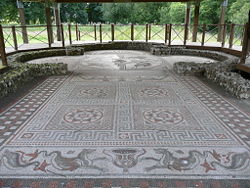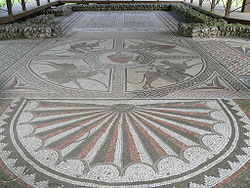
Littlecote Roman Villa
Encyclopedia


Roman Britain
Roman Britain was the part of the island of Great Britain controlled by the Roman Empire from AD 43 until ca. AD 410.The Romans referred to the imperial province as Britannia, which eventually comprised all of the island of Great Britain south of the fluid frontier with Caledonia...
winged corridor villa
Roman villa
A Roman villa is a villa that was built or lived in during the Roman republic and the Roman Empire. A villa was originally a Roman country house built for the upper class...
and associated religious complex at Littlecote Park
Littlecote House
Littlecote House is a large Elizabethan country house and estate in the civil parishes of Ramsbury and Chilton Foliat in the English county of Wiltshire near to Hungerford. The estate includes 34 hectares of historic parklands and gardens, including a walled garden from the 17th and 18th centuries...
in the civil parish
Civil parish
In England, a civil parish is a territorial designation and, where they are found, the lowest tier of local government below districts and counties...
of Ramsbury
Ramsbury
Ramsbury is a village in Ramsbury and Axford civil parish in the English county of Wiltshire. The village is in the Kennet Valley near the Berkshire boundary. The nearest towns are Hungerford about east and Marlborough about west. The much larger town of Swindon is about to the north.The civil...
in the English
England
England is a country that is part of the United Kingdom. It shares land borders with Scotland to the north and Wales to the west; the Irish Sea is to the north west, the Celtic Sea to the south west, with the North Sea to the east and the English Channel to the south separating it from continental...
county of Wiltshire
Wiltshire
Wiltshire is a ceremonial county in South West England. It is landlocked and borders the counties of Dorset, Somerset, Hampshire, Gloucestershire, Oxfordshire and Berkshire. It contains the unitary authority of Swindon and covers...
. It has been archaeologically excavated under the direction of Bryn Walters, and is on display to the public.
History
The settlement may have begun life as a small short-lived military establishment guarding a crossingFord (crossing)
A ford is a shallow place with good footing where a river or stream may be crossed by wading or in a vehicle. A ford is mostly a natural phenomenon, in contrast to a low water crossing, which is an artificial bridge that allows crossing a river or stream when water is low.The names of many towns...
of the River Kennet
River Kennet
The Kennet is a river in the south of England, and a tributary of the River Thames. The lower reaches of the river are navigable to river craft and are known as the Kennet Navigation, which, together with the Avon Navigation, the Kennet and Avon Canal and the Thames, links the cities of Bristol...
. This was replaced by local circular farming huts around AD 70
70
Year 70 was a common year starting on Monday of the Julian calendar. At the time, it was known as the Year of the Consulship of Augustus and Vespasianus...
and a Roman-style rectangular building fifty years later. Activity involved baking ovens, malting tanks and grinding stones. After another fifty years, this was replaced by a large two-storeyed winged corridor villa with integral bath suite. This building went through a number of changes over the subsequent centuries, notably a major rebuilding around AD 270
270
Year 270 was a common year starting on Saturday of the Julian calendar. At the time, it was known as the Year of the Consulship of Antiochianus and Orfitus...
. The villa had a number of mosaic
Mosaic
Mosaic is the art of creating images with an assemblage of small pieces of colored glass, stone, or other materials. It may be a technique of decorative art, an aspect of interior decoration, or of cultural and spiritual significance as in a cathedral...
s and there were detached workshops, barns and a large gatehouse.
Around AD 360
360
Year 360 was a leap year starting on Saturday of the Julian calendar. At the time, it was known as the Year of the Consulship of Constantius and Iulianus...
, from numismatic
Numismatics
Numismatics is the study or collection of currency, including coins, tokens, paper money, and related objects. While numismatists are often characterized as students or collectors of coins, the discipline also includes the broader study of money and other payment media used to resolve debts and the...
evidence, agricultural activity seems to have ended and the complex acquired a religious use. A large barn was converted into a courtyard and a very early triconch hall was built alongside with its own bath suite. Upon its floor was laid a now famous Orpheus
Orpheus
Orpheus was a legendary musician, poet, and prophet in ancient Greek religion and myth. The major stories about him are centered on his ability to charm all living things and even stones with his music; his attempt to retrieve his wife from the underworld; and his death at the hands of those who...
mosaic, first discovered in 1727 by the Steward of the Littlecote Park estate.
This mosaic is usually interpreted in very complicated pagan religious
Roman mythology
Roman mythology is the body of traditional stories pertaining to ancient Rome's legendary origins and religious system, as represented in the literature and visual arts of the Romans...
terms involving not only Orpheus, but Bacchus
Dionysus
Dionysus was the god of the grape harvest, winemaking and wine, of ritual madness and ecstasy in Greek mythology. His name in Linear B tablets shows he was worshipped from c. 1500—1100 BC by Mycenean Greeks: other traces of Dionysian-type cult have been found in ancient Minoan Crete...
and Apollo
Apollo
Apollo is one of the most important and complex of the Olympian deities in Greek and Roman mythology...
, the hall being seen as a cult
Cult
The word cult in current popular usage usually refers to a group whose beliefs or practices are considered abnormal or bizarre. The word originally denoted a system of ritual practices...
centre for these two gods. Other buildings may have been converted to accommodate visiting pilgrim
Pilgrim
A pilgrim is a traveler who is on a journey to a holy place. Typically, this is a physical journeying to some place of special significance to the adherent of a particular religious belief system...
s. This development has been associated with the pagan revival under Julian the Apostate
Julian the Apostate
Julian "the Apostate" , commonly known as Julian, or also Julian the Philosopher, was Roman Emperor from 361 to 363 and a noted philosopher and Greek writer....
(361-363).
Many of the buildings were demolished or fell into decay around AD 400
400
Year 400 was a leap year starting on Sunday of the Julian calendar. At the time, it was known as the Year of the Consulship of Stilicho and Aurelianus...
, shortly after the Theodosian
Theodosius I
Theodosius I , also known as Theodosius the Great, was Roman Emperor from 379 to 395. Theodosius was the last emperor to rule over both the eastern and the western halves of the Roman Empire. During his reign, the Goths secured control of Illyricum after the Gothic War, establishing their homeland...
legislation against paganism and before the Roman withdrawal from Britain. Two sub-Roman
Sub-Roman Britain
Sub-Roman Britain is a term derived from an archaeological label for the material culture of Britain in Late Antiquity: the term "Sub-Roman" was invented to describe the potsherds in sites of the 5th century and the 6th century, initially with an implication of decay of locally-made wares from a...
timber structures have also been identified on the site.

